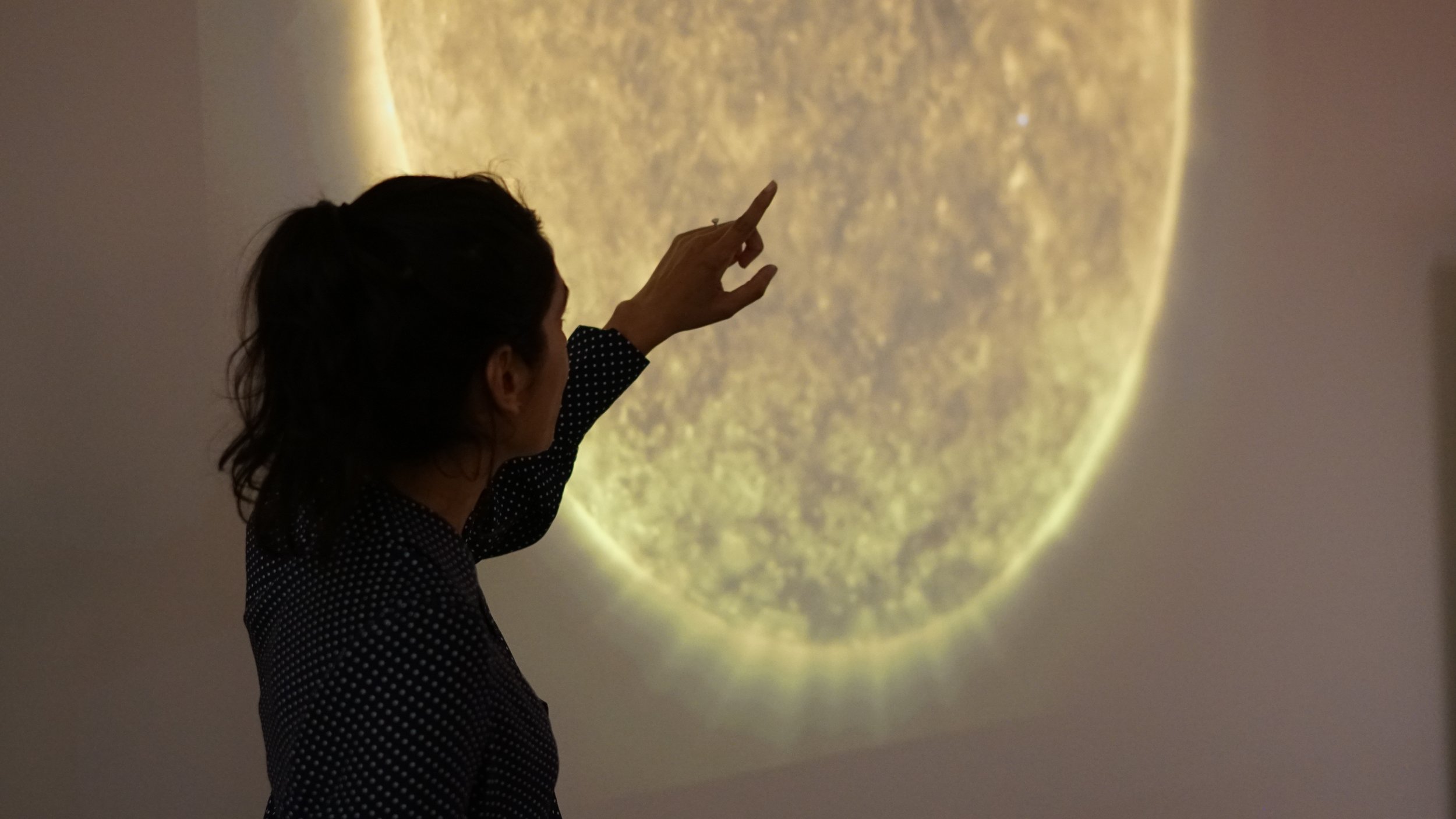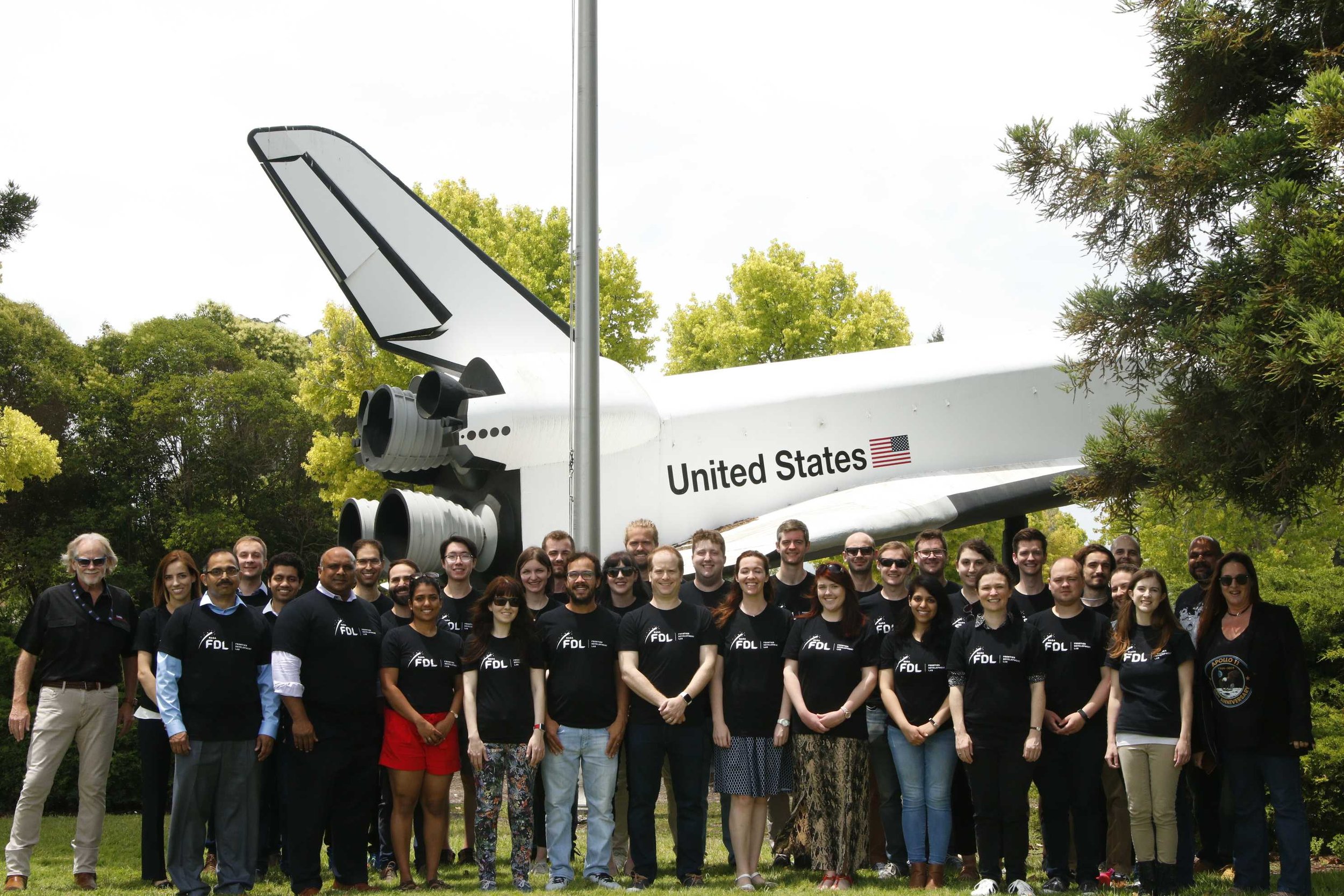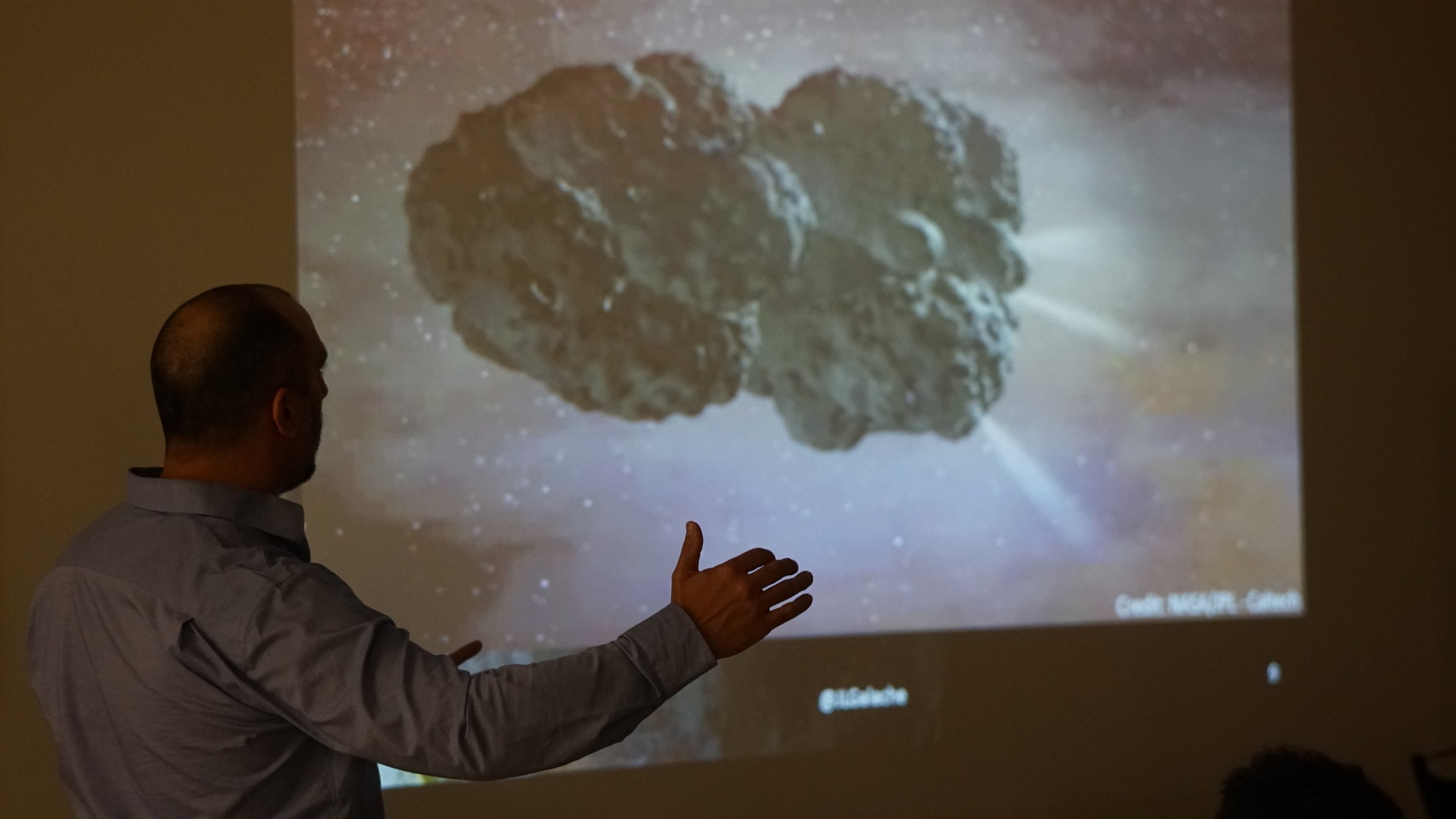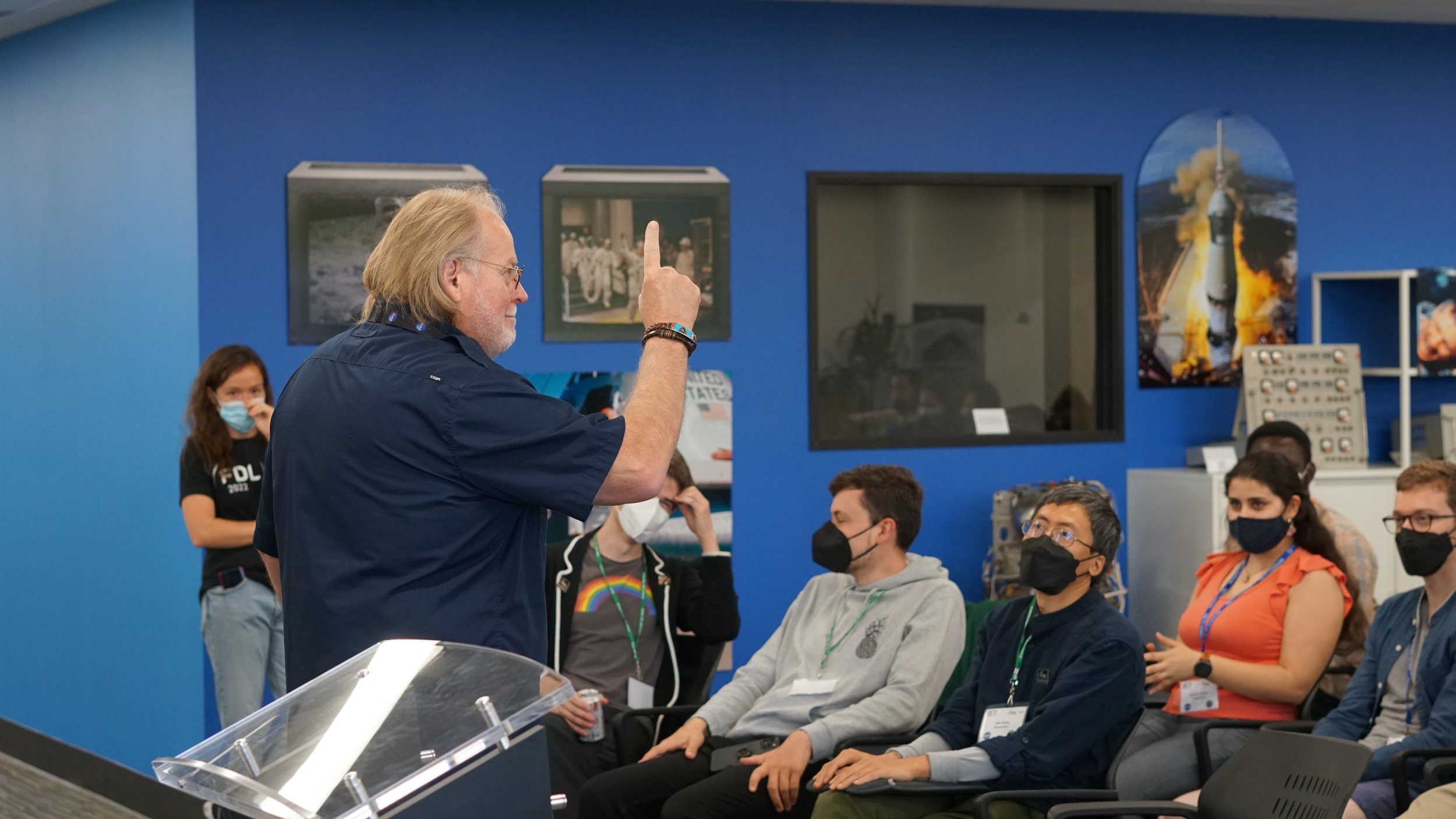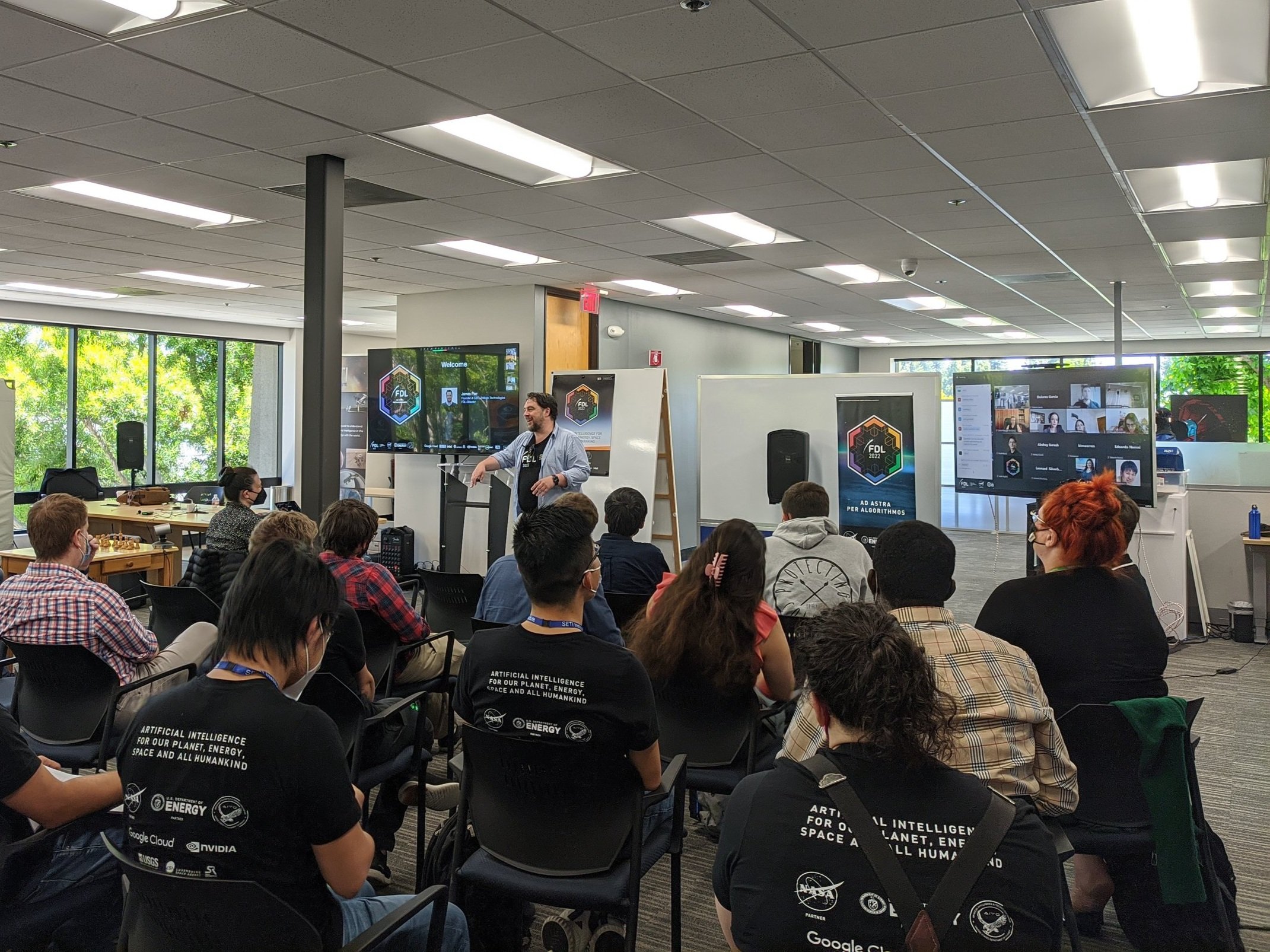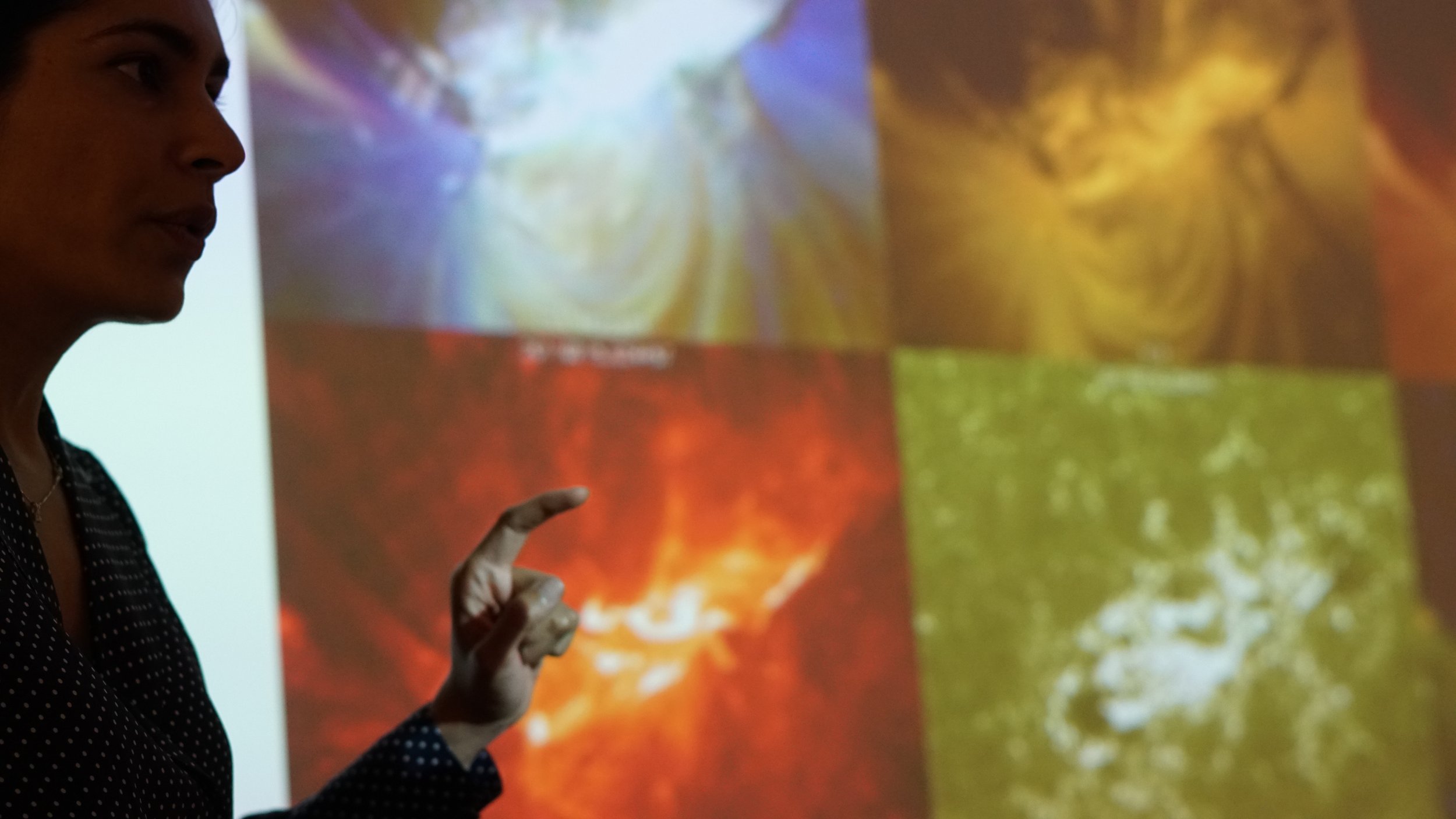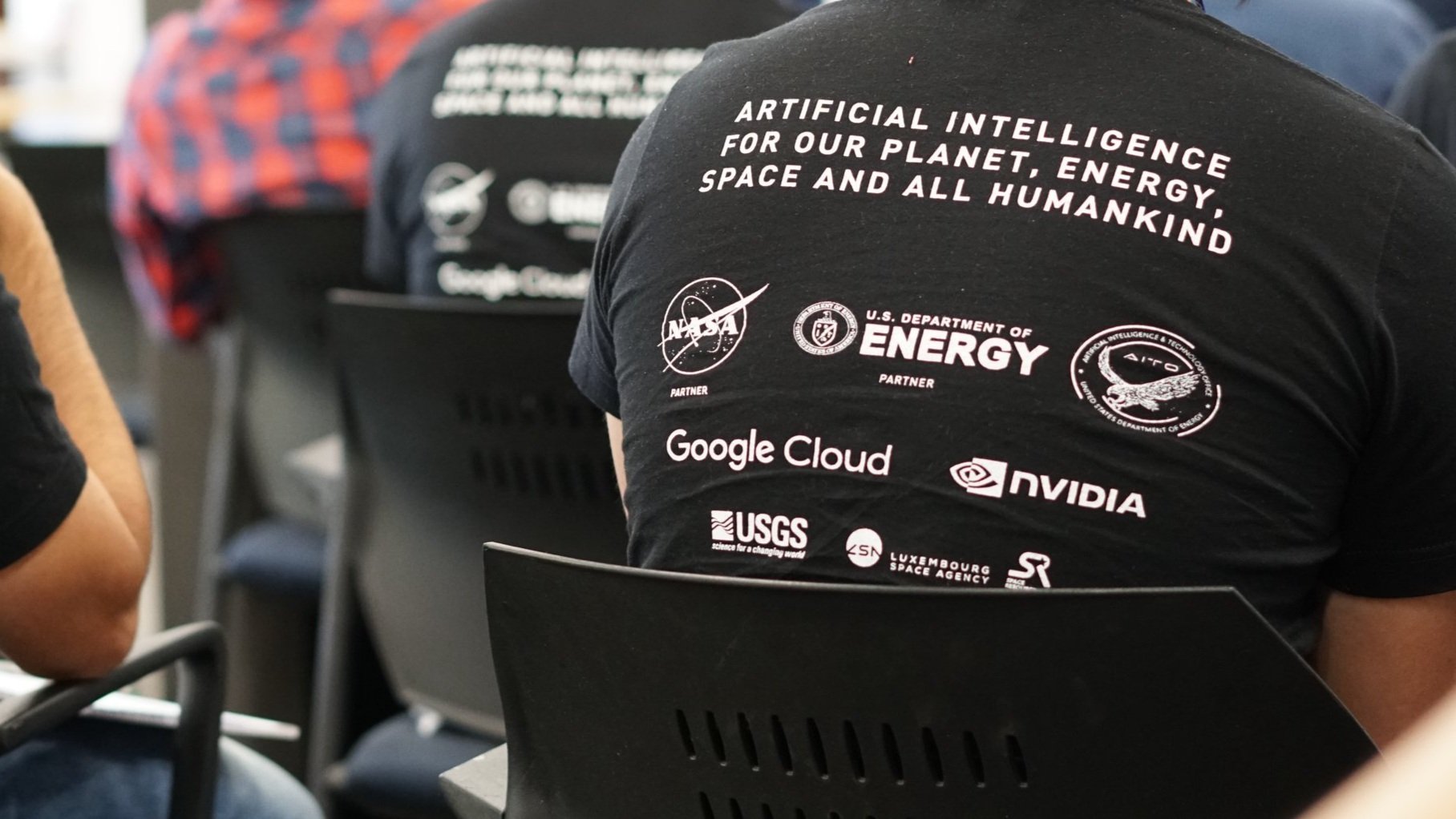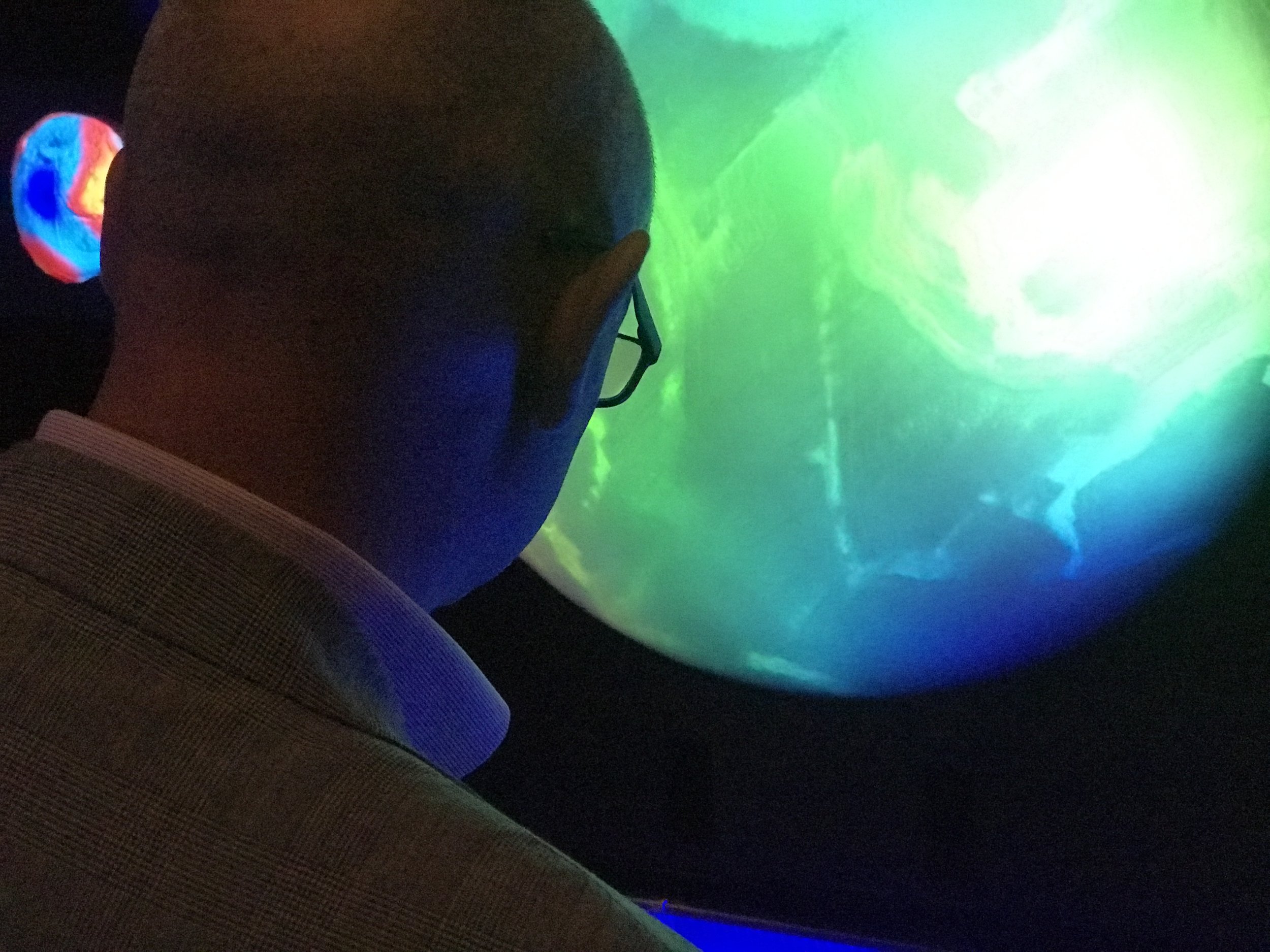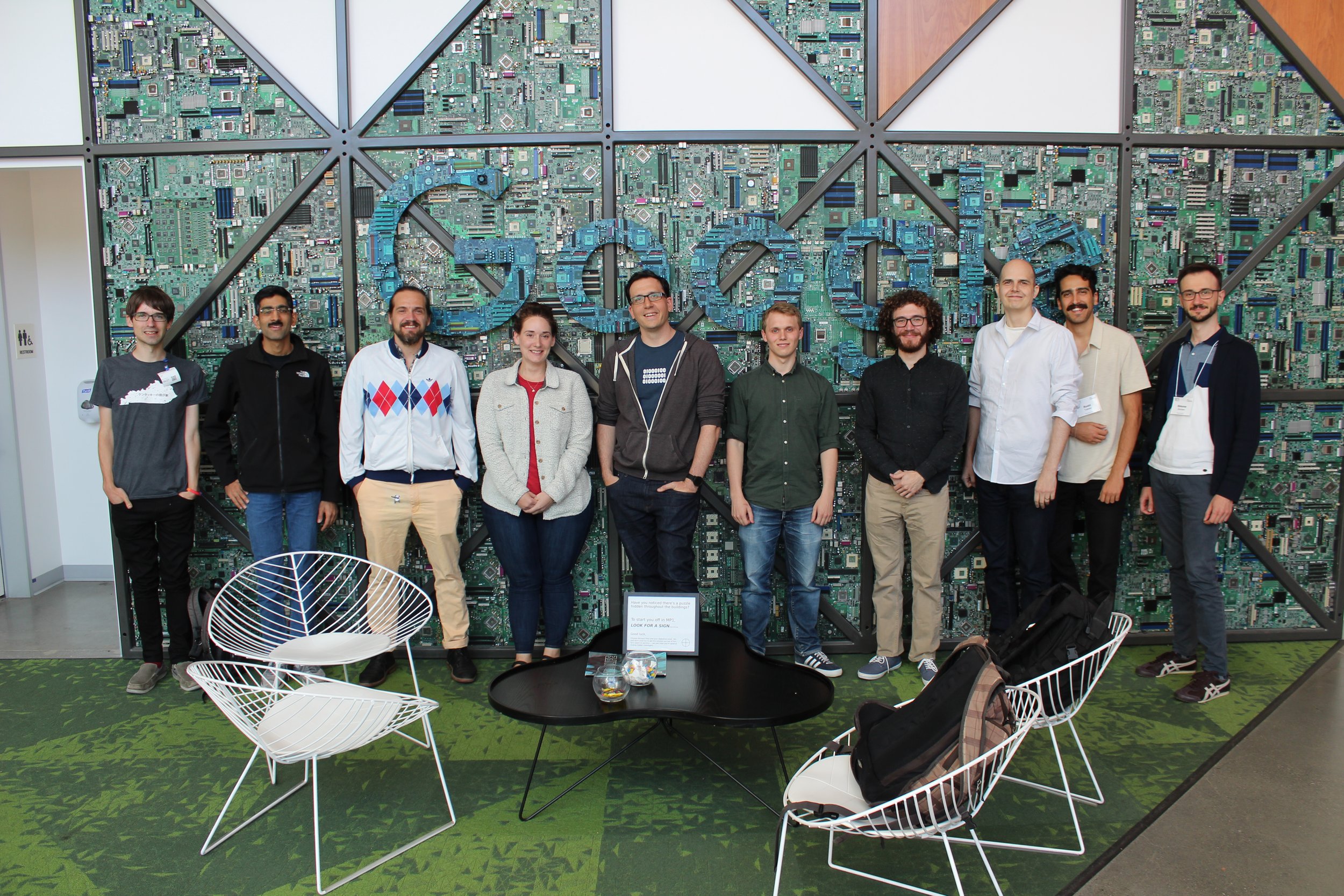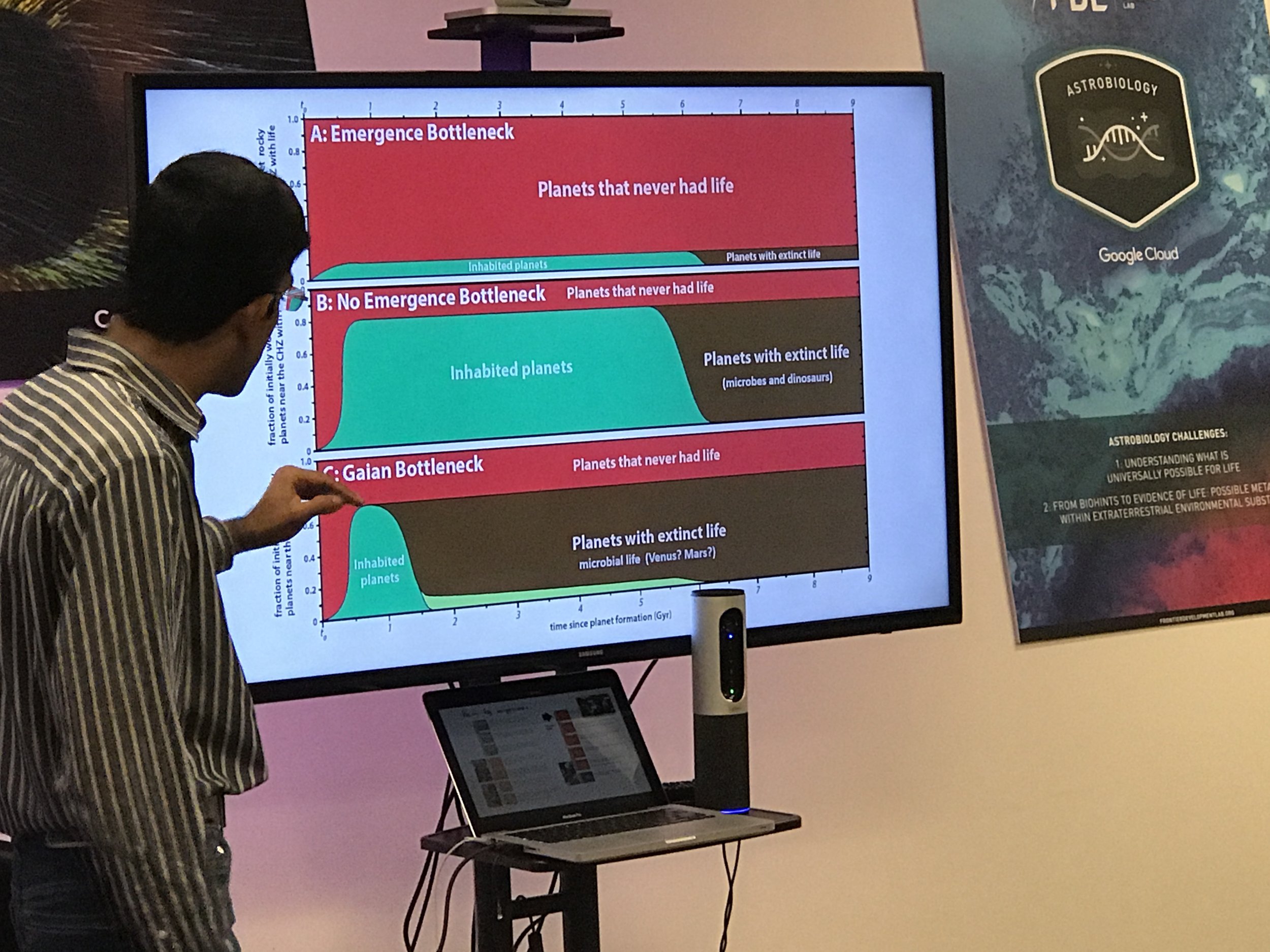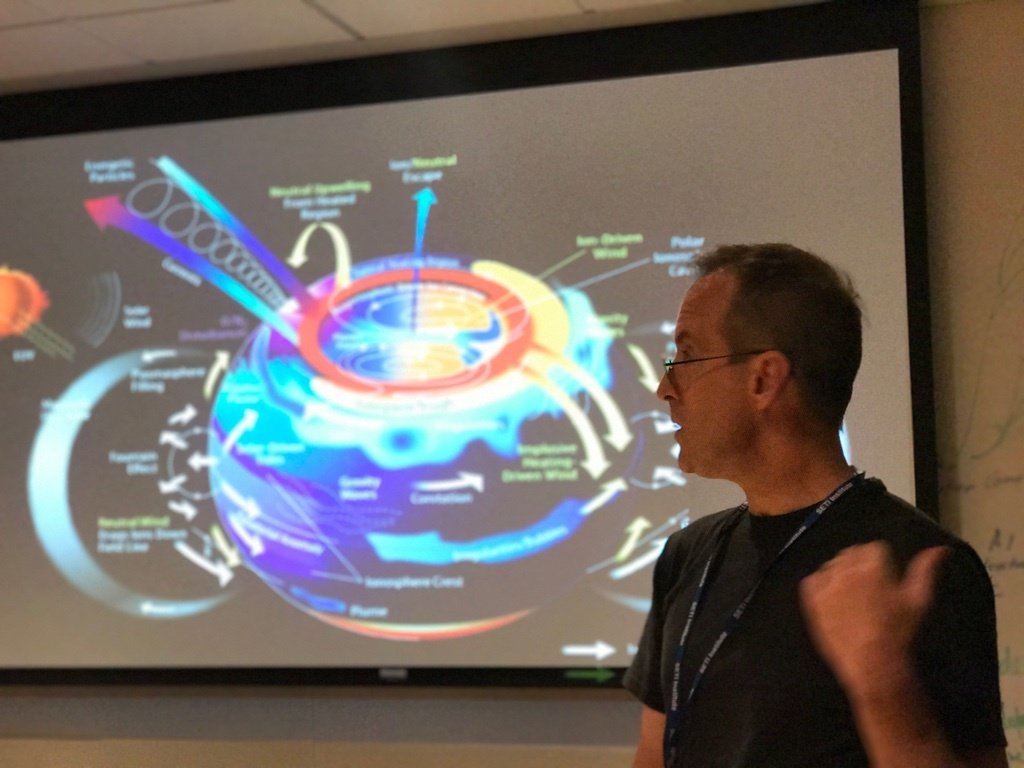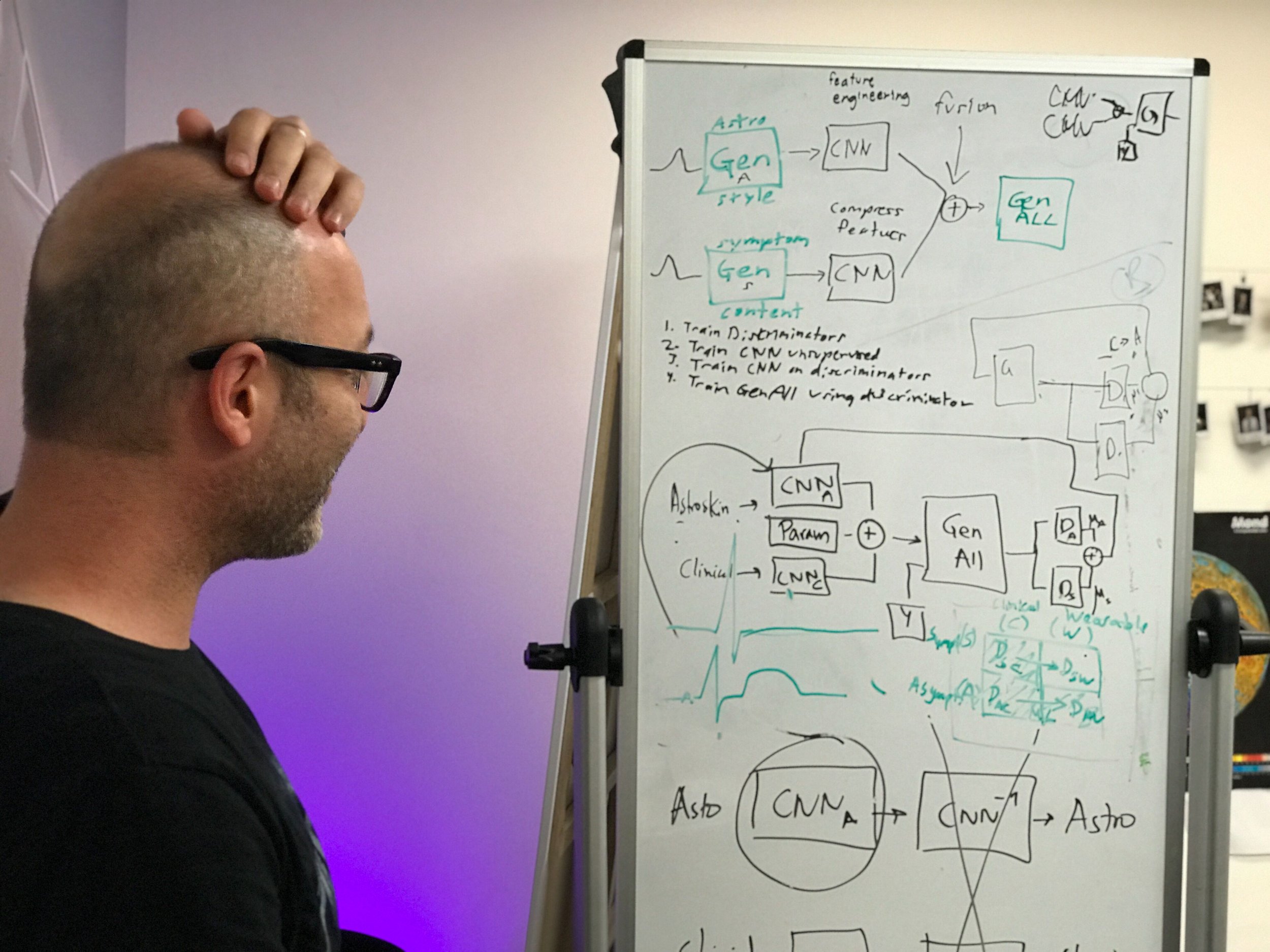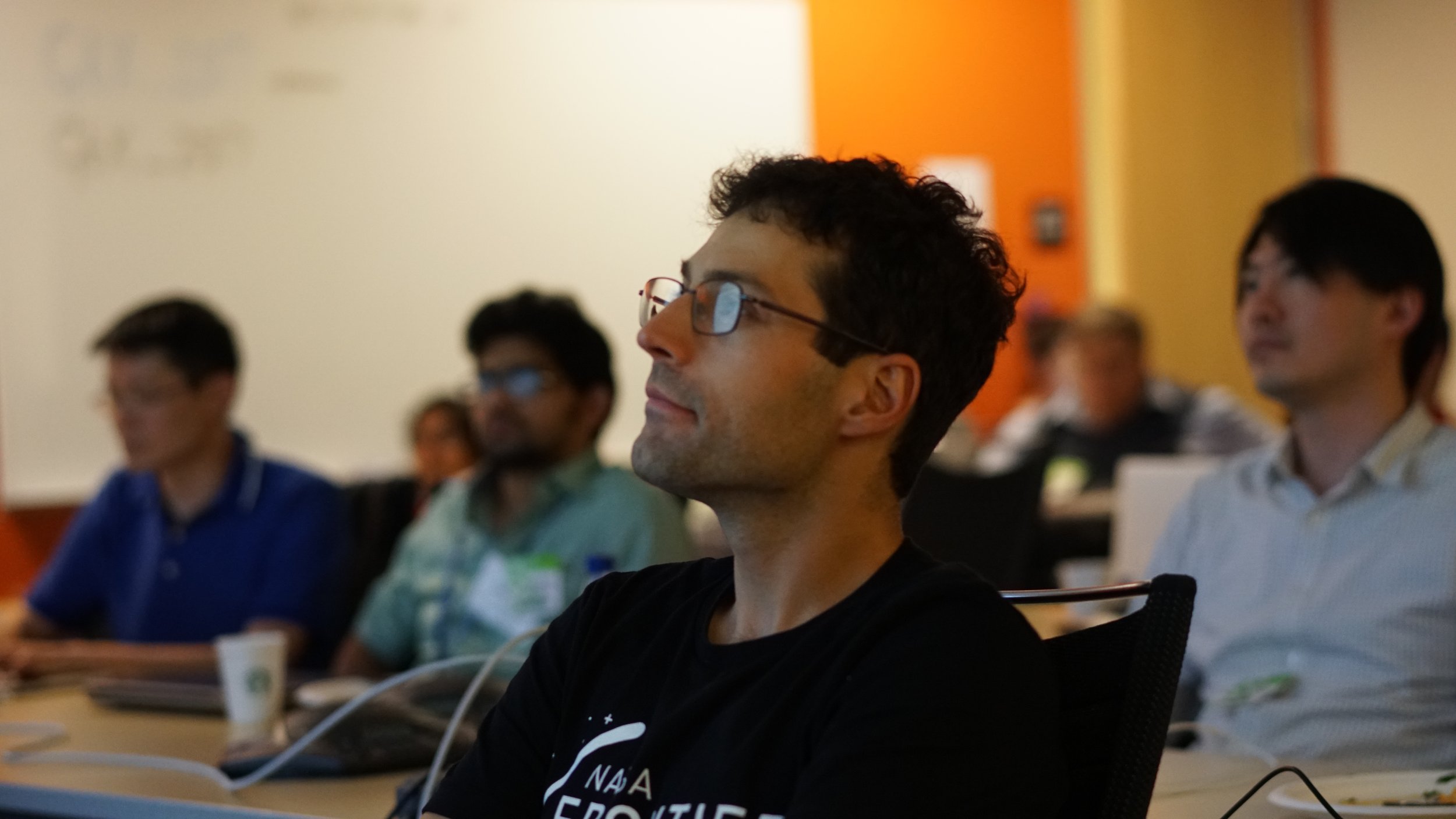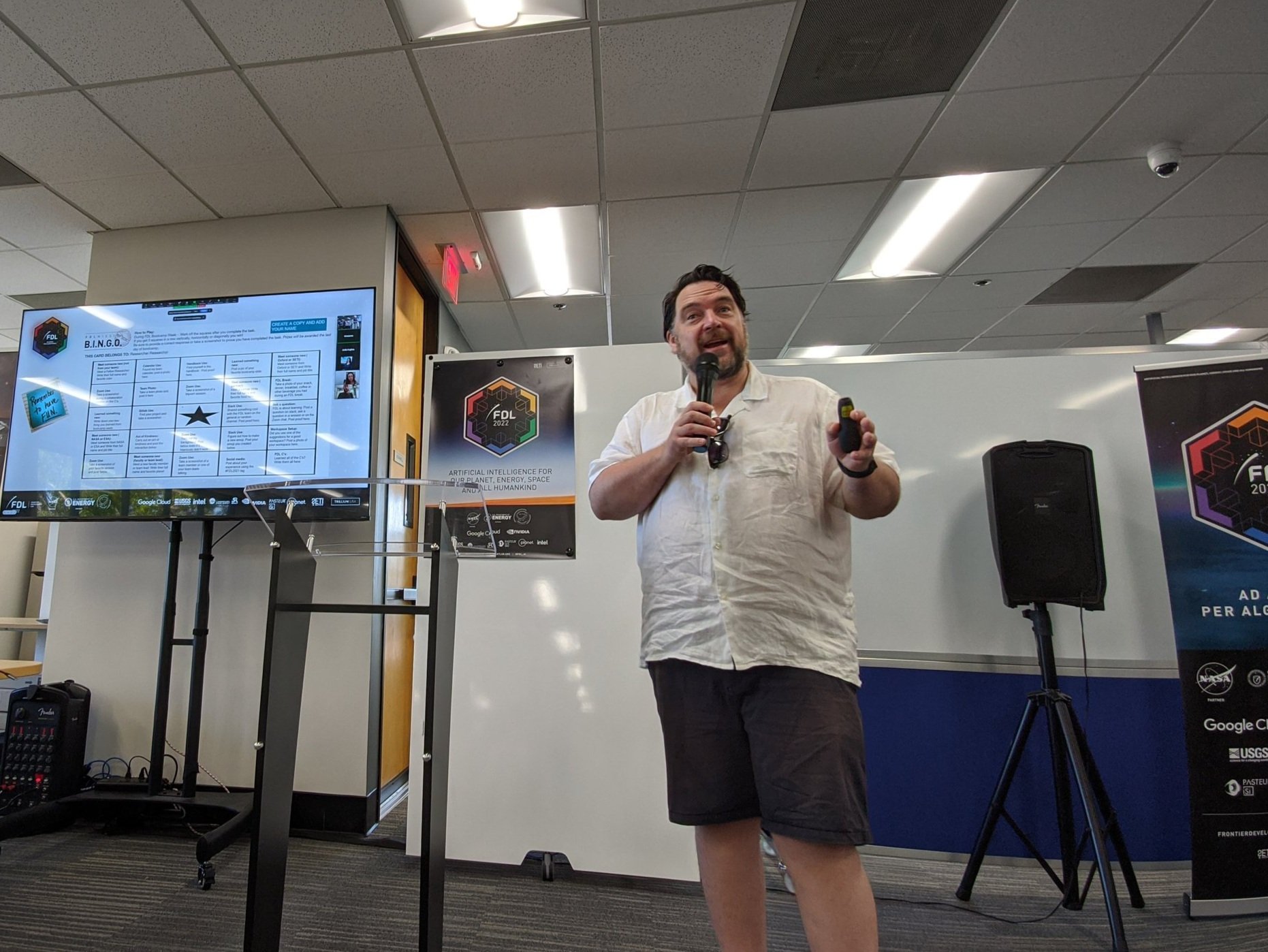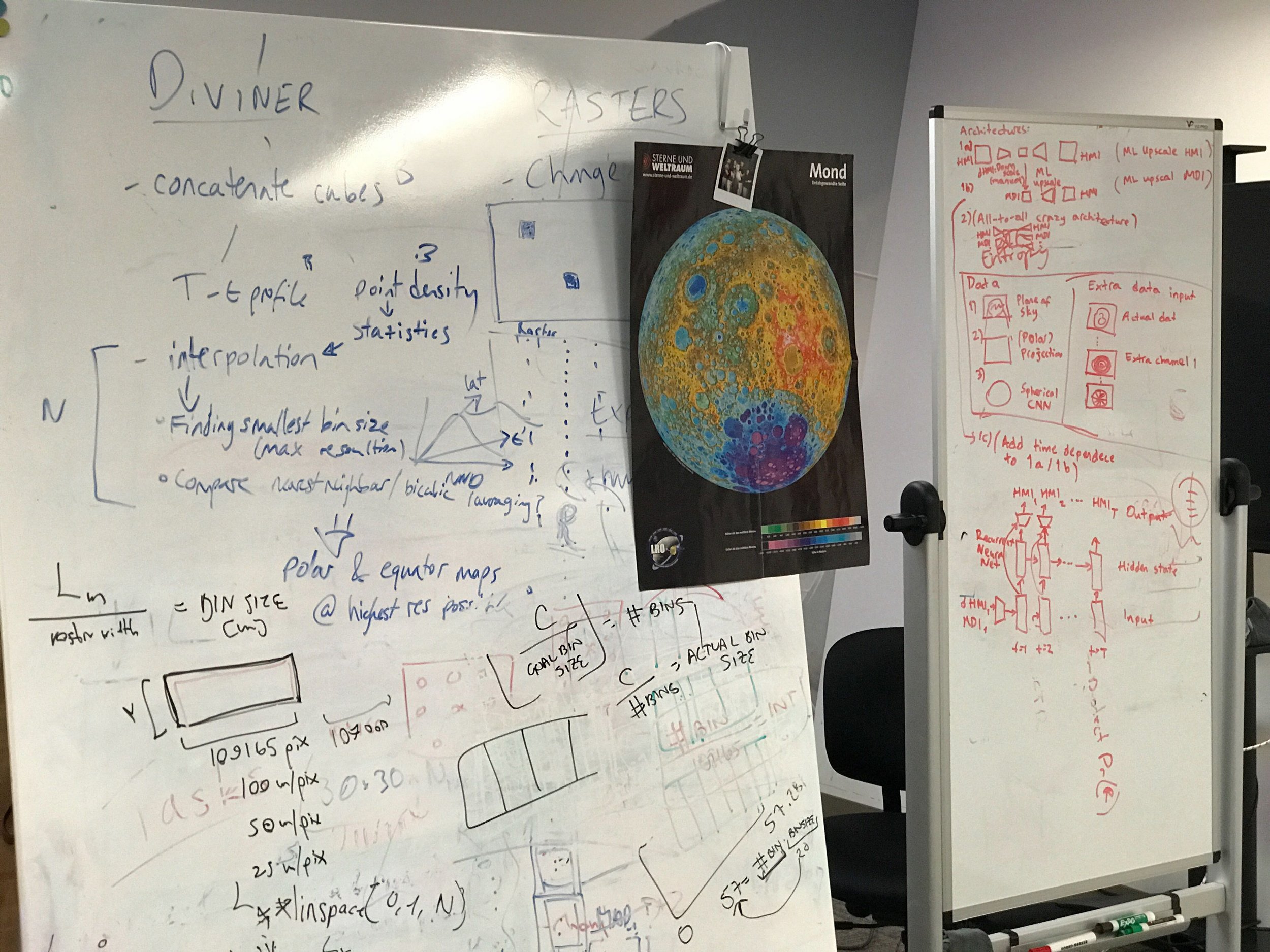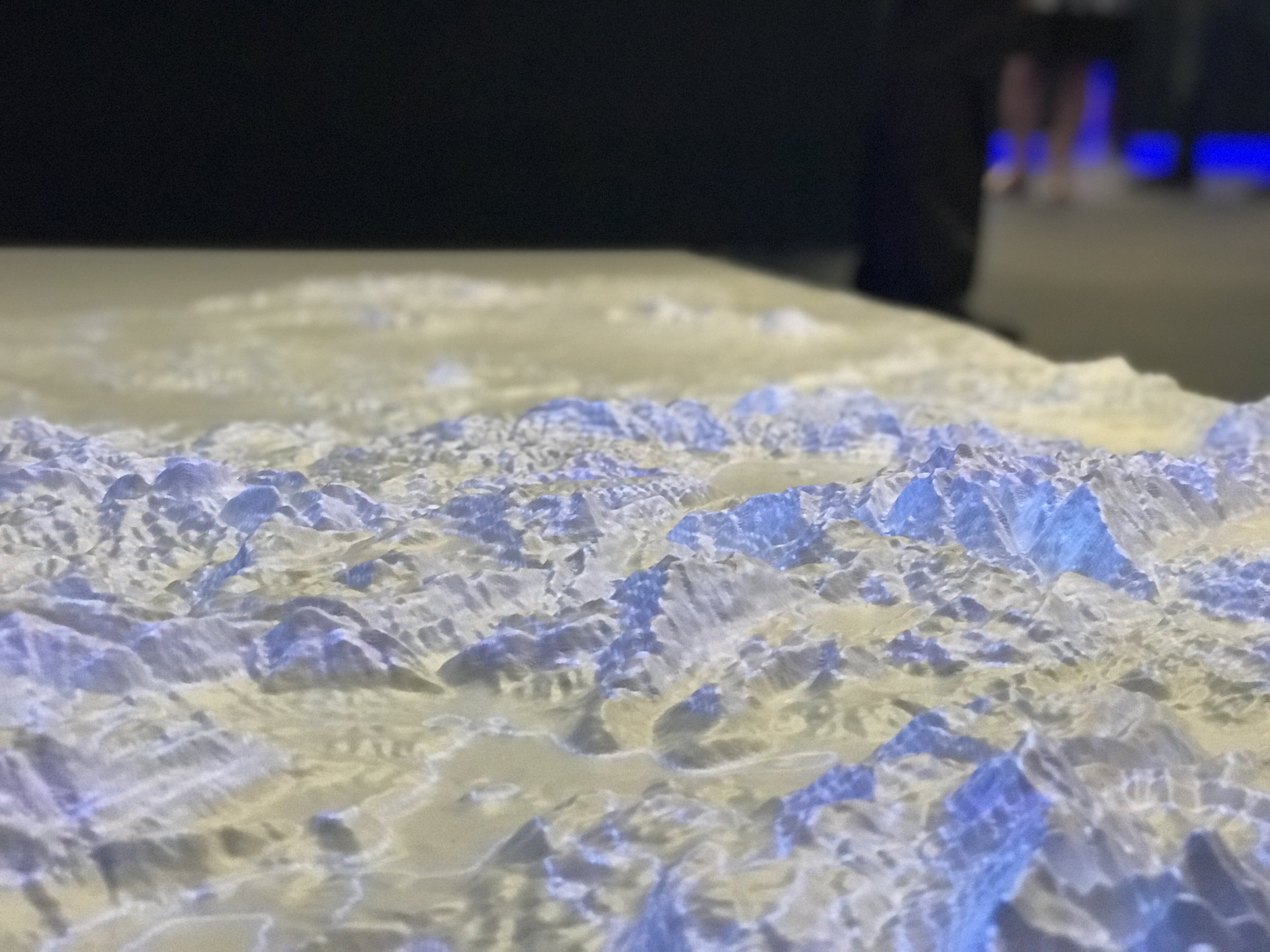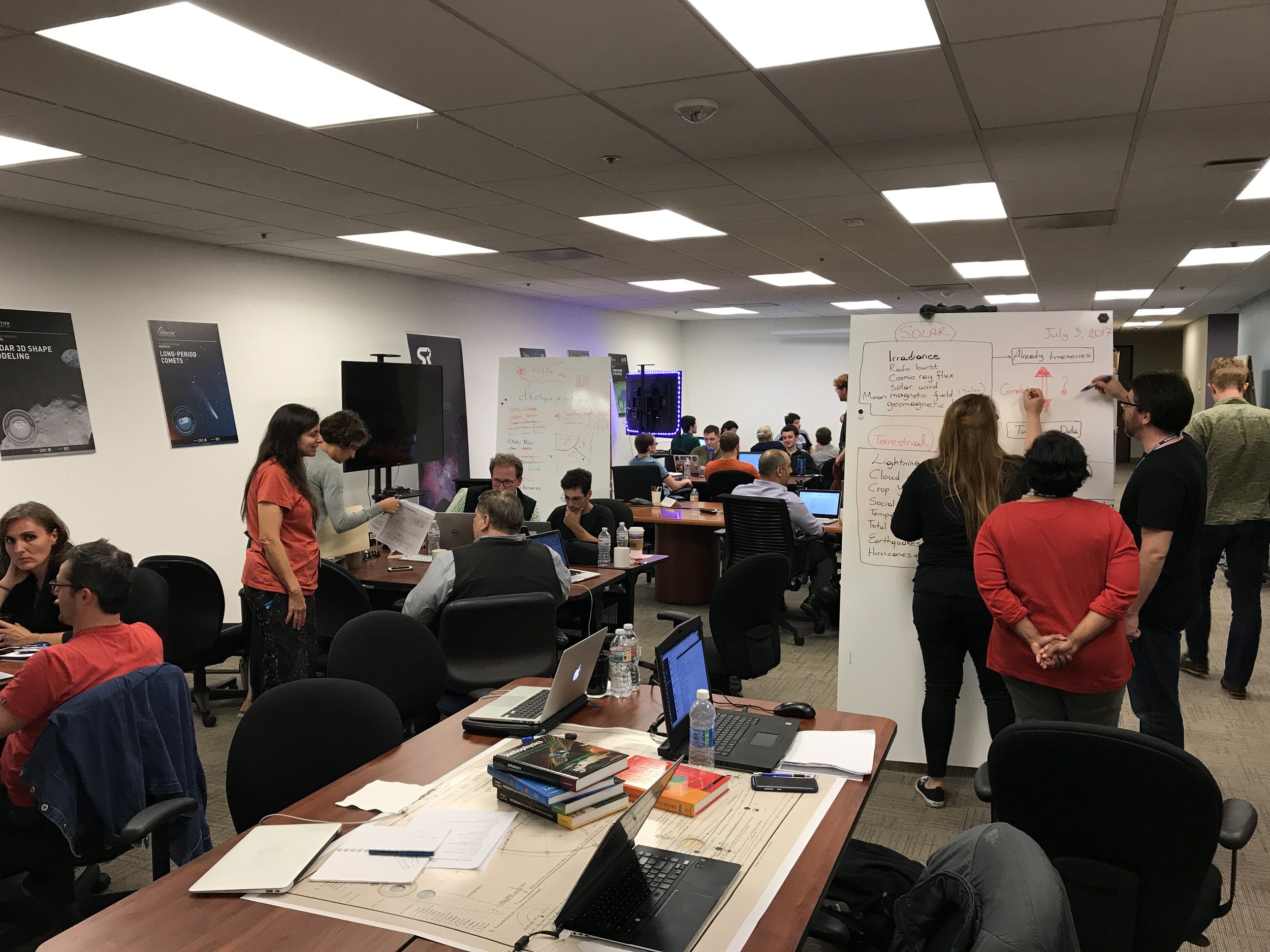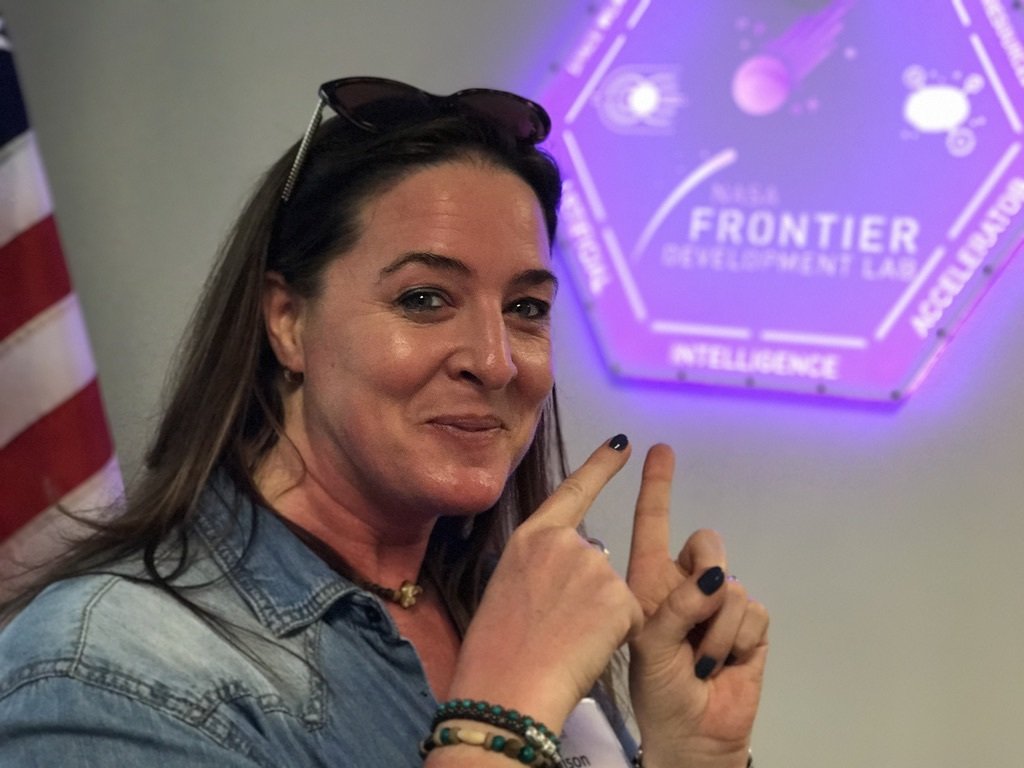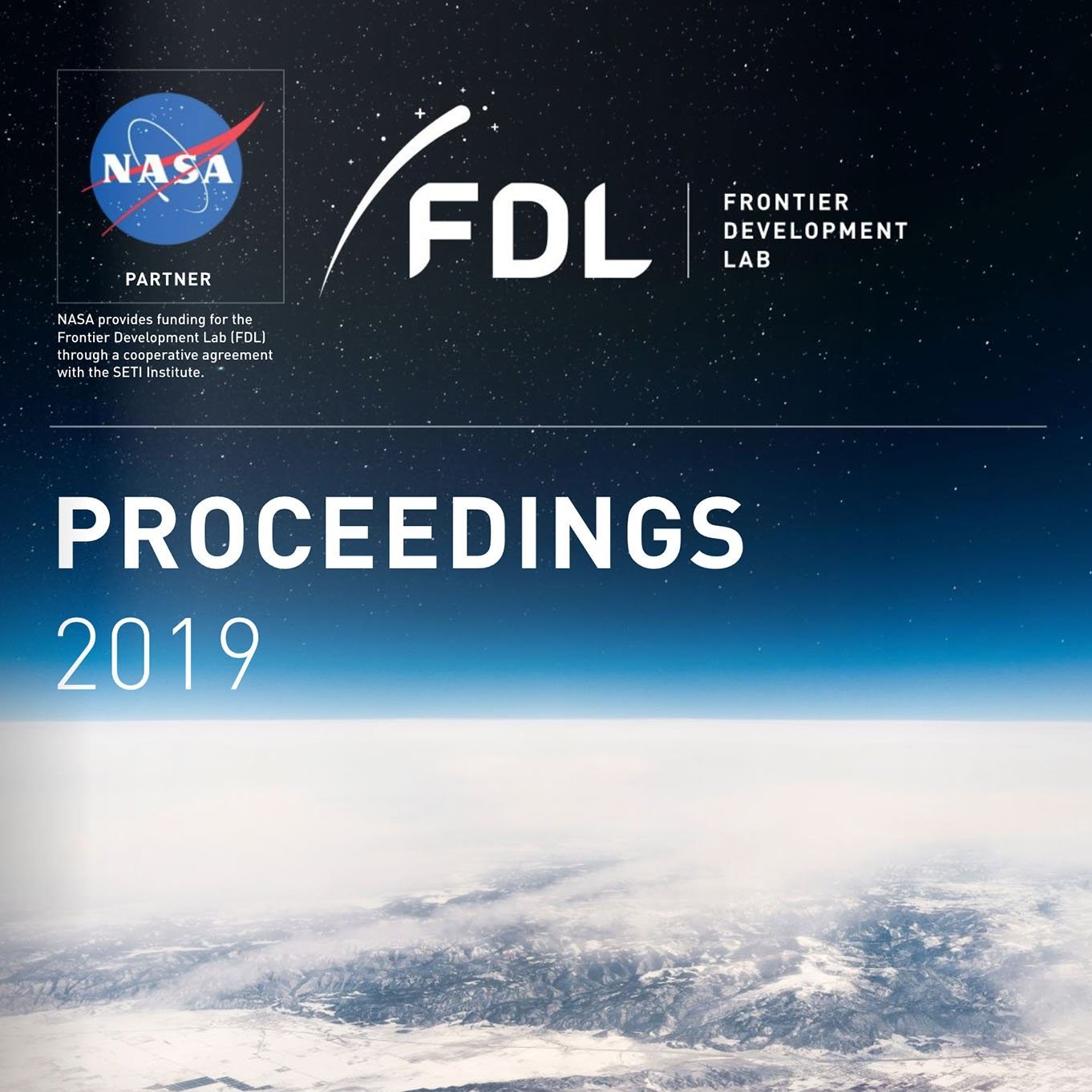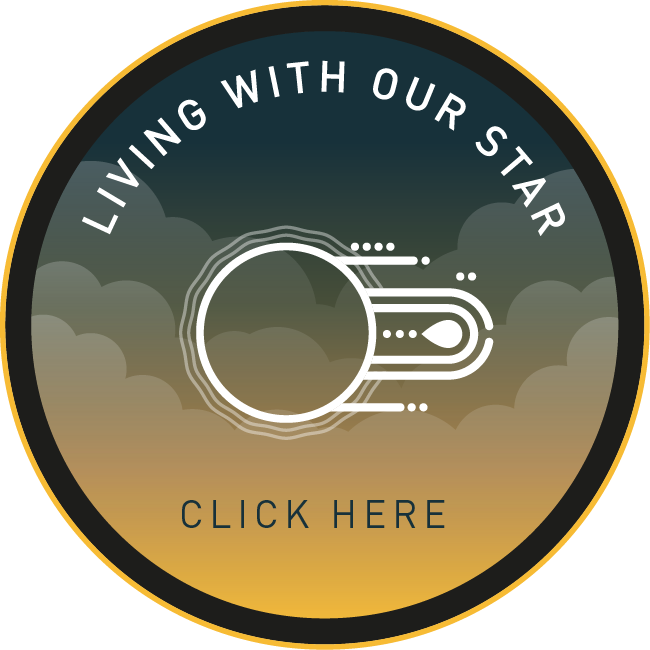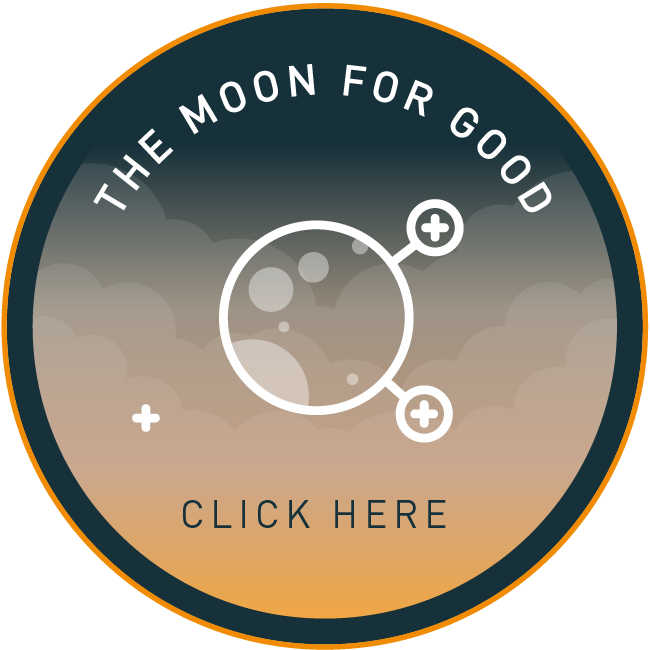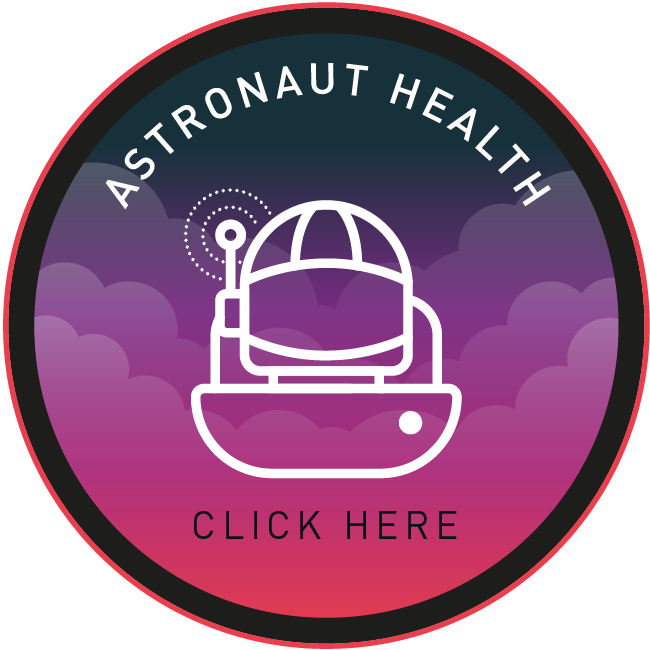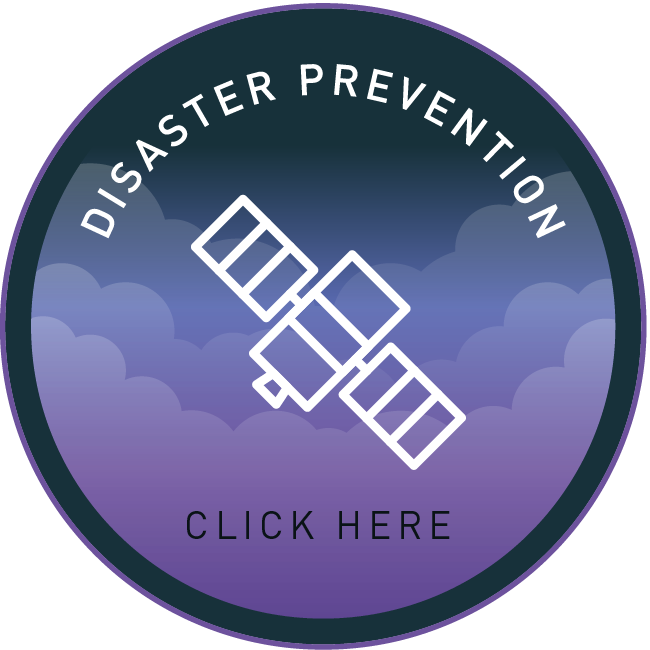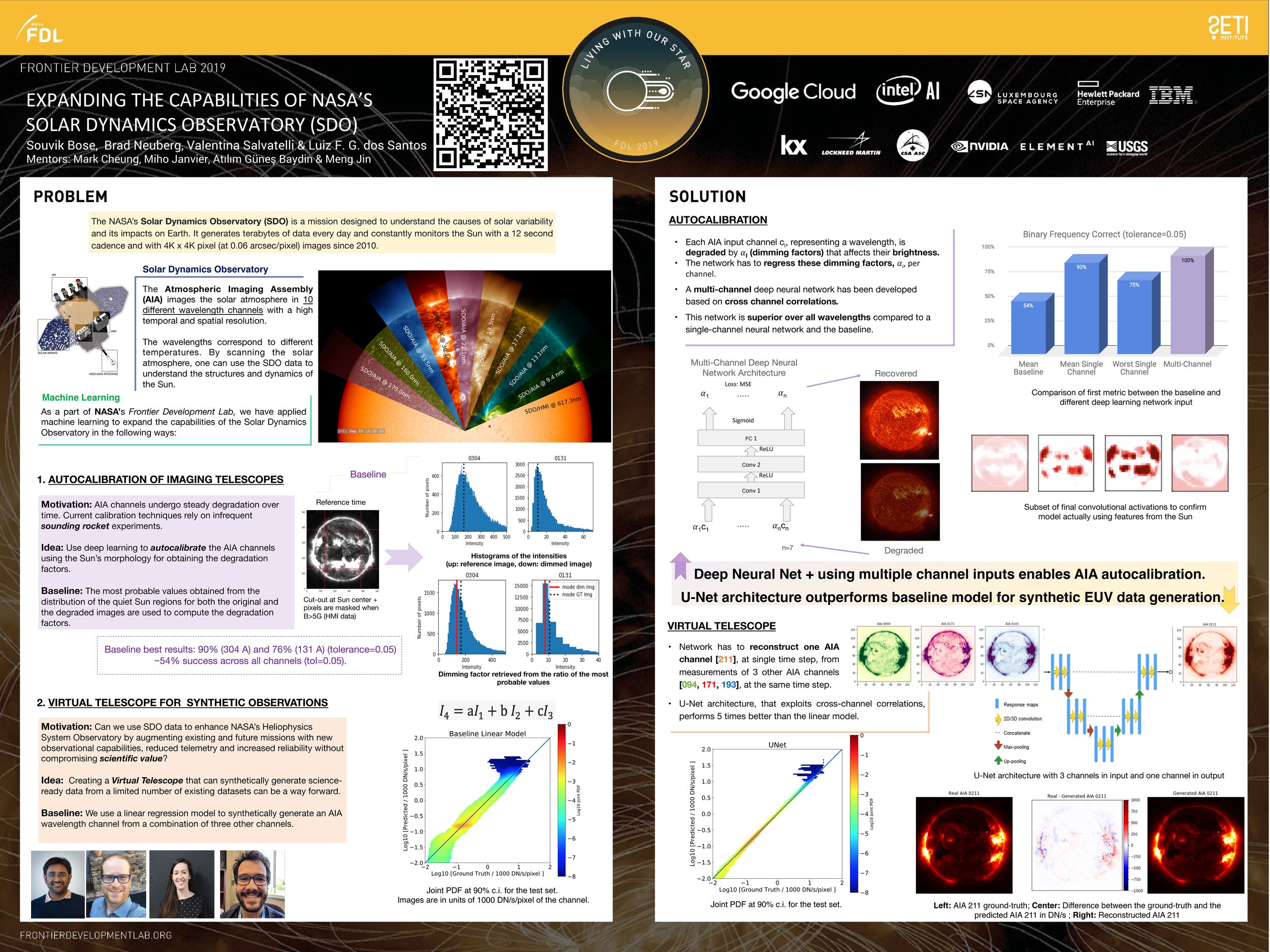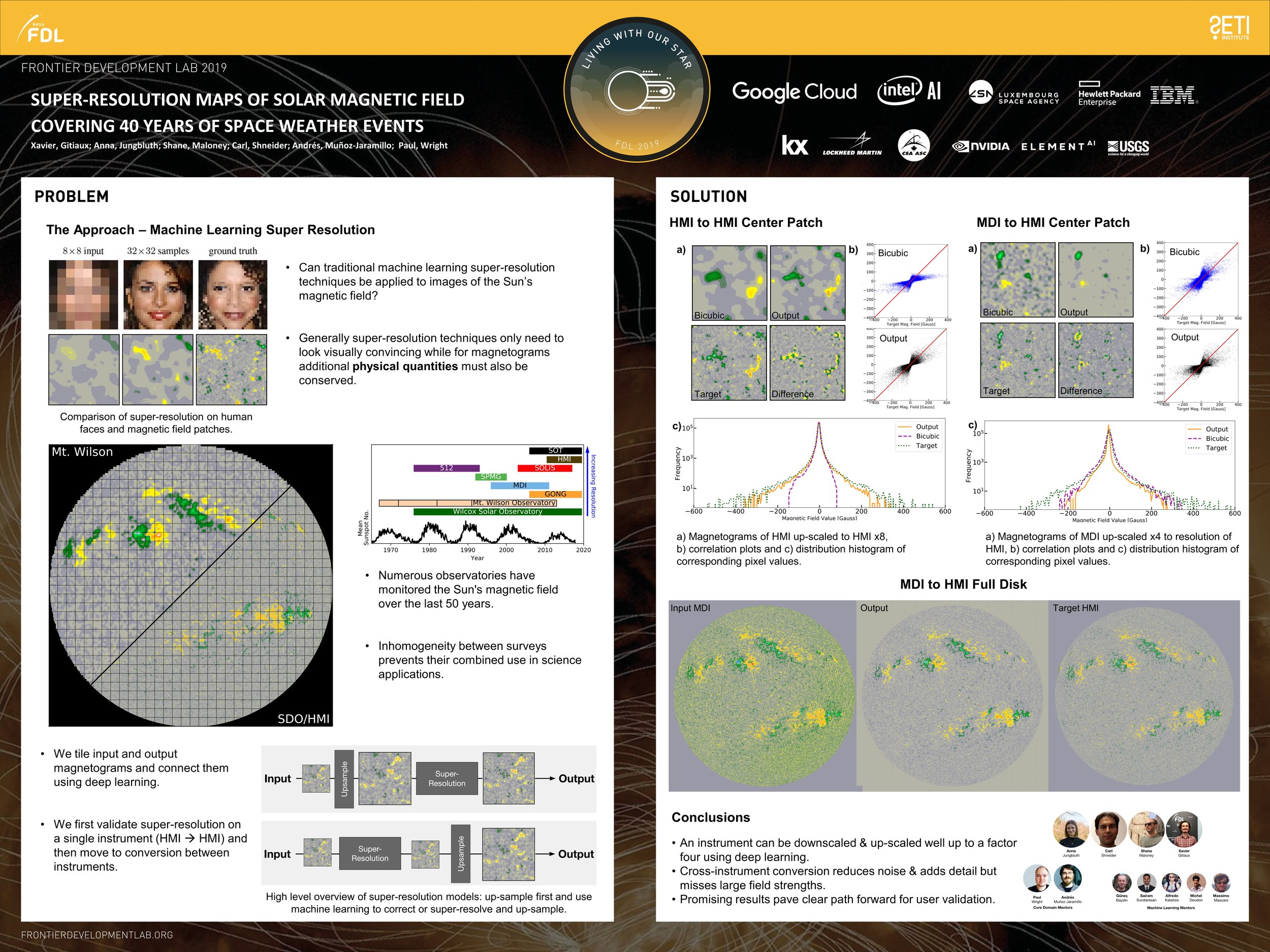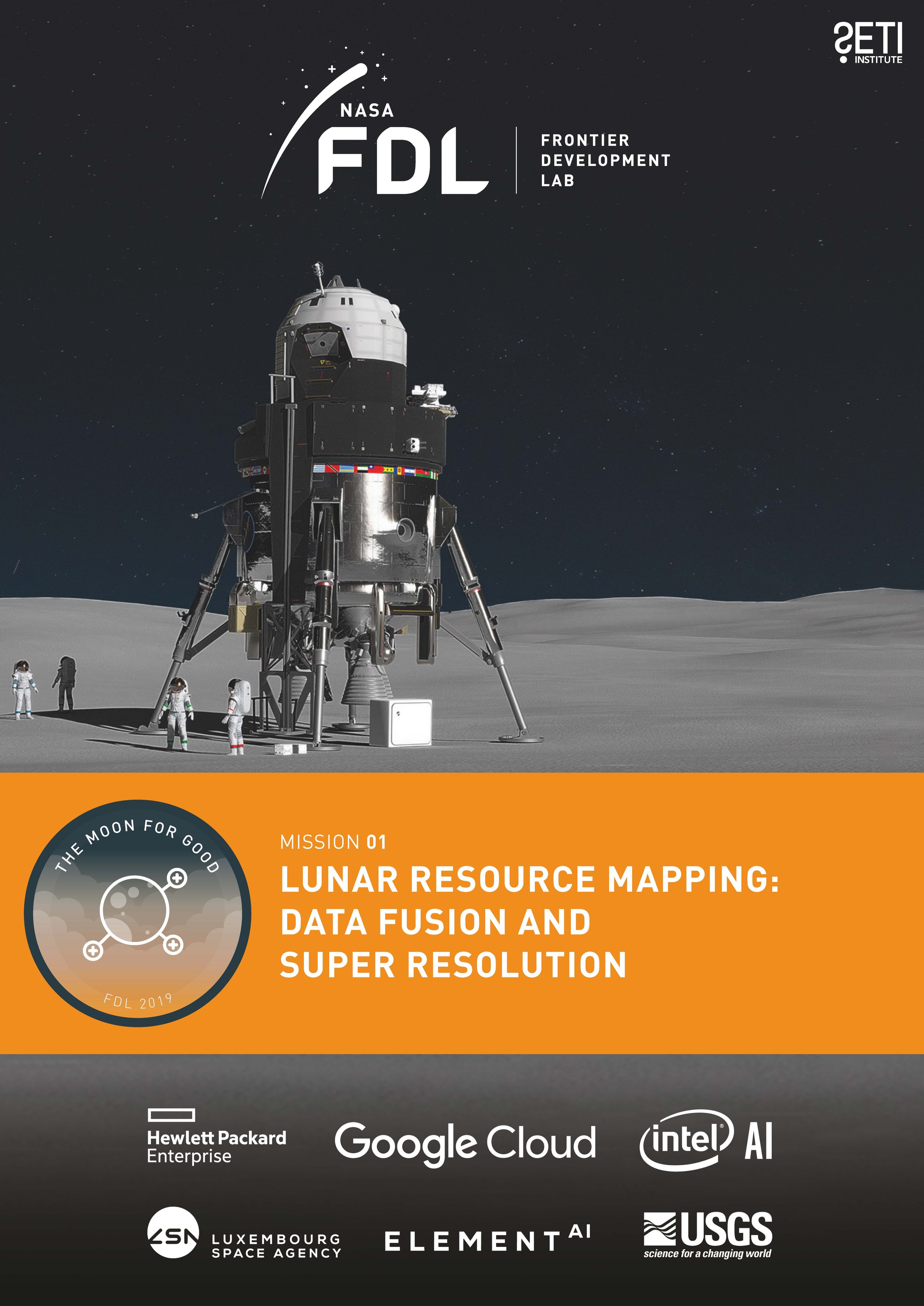
FDL 2019
In 2019 FDL tackled challenges in Heliophysics, Astronaut Health, Disaster Prevention and Lunar Exploration.
Navigate to research area
LIVING WITH OUR STAR
EXPANDING THE CAPABILITIES OF NASA’S SOLAR DYNAMICS OBSERVATORY
The team devised a way for solar extreme UV telescopes to self-calibrate, improving our capability to monitor space weather. Furthermore, the team created a synthetic telescope to image the Sun’s corona.
-
-
Living with our star: Expanding the capabilities of NASA’s solar dynamics observatory
Authors: Souvik Bose, Brad Neuberg, Valentina Salvatelli , Luiz F. G. dos Santos
Mentors: Mark Cheung, Miho Janvier, Atılım Güneş Baydin, Meng Jin -
Using U-Nets to Create High-Fidelity Virtual Observations of the Solar Corona - DOI
Authors: Valentina Salvatelli, Souvik Bose, Brad Neuberg, Luiz F. G. dos Santos, Mark Cheung, Miho Janvier, Atilim Gunes Baydin, Yarin Gal, Meng Jin
Auto-Calibration of Remote Sensing Solar Telescopes with Deep Learning - DOI
Authors: Brad Neuberg, Souvik Bose, Valentina Salvatelli, Luiz F.G. dos Santos, Mark Cheung, Miho Janvier, Atilim Gunes Baydin, Yarin Gal, Meng Jin
Astronomy & Astrophysics Journal - Multi-Channel Auto-Calibration for the Atmospheric Imaging Assembly using Machine Learning - DOI - ArXiv
Authors: Luiz F. G. dos Santos, Souvik Bose, Valentina Salvatelli, Brad Neuberg, Mark C. M. Cheung, Miho Janvier, Meng Jin, Yarin Gal, Paul Boerner, Atılım Güneş BaydinAstrophysical Journal Letters - A Machine-learning Data Set Prepared from the NASA Solar Dynamics Observatory Mission - DOI
-
AGU 2019: Auto-calibration and reconstruction of SDO’s Atmospheric Imaging Assembly channels with Deep Learning
Authors: Chun Ming Mark Cheung, Luiz Fernando Guedes dos Santos, Souvik Bose, Brad Neuberg, Valentina Salvatelli, Atılım Güneş Baydin, Miho Janvier.
AGU 2020: Multi-Channel Auto-Calibration for the Atmospheric Imaging Assembly instrument with Deep Learning
Authors: Souvik Bose, Luiz Fernando Guedes dos Santos, Valentina Salvatelli, Brad Neuberg, Chun Ming Mark Cheung, Miho Janvier, Meng Jin, Yarin Gal, Atılım Güneş Baydin.NeurIPS 2019 ML4PS - Auto-Calibration of Remote Sensing Solar Telescopes with Deep Learning
Authors: Brad Neuberg, Souvik Bose, Valentina Salvatelli, Luiz F.G. dos Santos, Mark Cheung, Miho Janvier, Atilim Gunes Baydin, Yarin Gal, Meng Jin.
NeurIPS 2019 ML4PS -Using U-Nets to Create High-Fidelity Virtual Observations of the Solar Corona
Authors: Valentina Salvatelli, Souvik Bose, Brad Neuberg, Luiz F. G. dos Santos, Mark Cheung, Miho Janvier, Atilim Gunes Baydin, Yarin Gal, Meng Jin
JPL AI and Data Science Workshop - Auto-Calibration and High-Fidelity Virtual Observations of Remote Sensing Solar Telescopes with Deep Learning - Abstract
Authors: Brad Neuberg, Souvik Bose, Valentina Salvatelli, Luiz F.G. dos Santos, Mark Cheung, Miho Janvier, Atilim Gunes Baydin, Yarin Gal, Meng Jin.
-
SpaceML.org - SDOML
A Machine Learning Dataset Prepared From the NASA Solar Dynamics Observatory Mission
SpaceML.org - SDO: Autocalibration
Multichannel auto-calibration for the Atmospheric Imaging Assembly using machine learning
LIVING WITH OUR STAR
SUPER-RESOLUTION MAPS OF SOLAR MAGNETIC FIELD COVERING 40 YEARS OF SPACE WEATHER EVENTS
Used state of the art deep neural networks to calibrate and super-resolve historical maps of the solar magnetic field.
-
-
Living with our star: super-resolution maps of solar magnetic field covering 40 years of space weather events
Authors: Xavier Gitiaux, Anna Jungbluth, Shane Maloney, Carl Shneider, Atılım Güneş Baydin, Alfredo Kalaitzis, Michel Deudon, Yarin Gal, Andrés Muñoz-Jaramillo, Paul Wright -
Single-Frame Super-Resolution of Solar Magnetograms: Investigating Physics-Based Metrics & Losses - DOI
Authors: Anna Jungbluth, Xavier Gitiaux, Shane A.Maloney, Carl Shneider, Paul J. Wright, Alfredo Kalaitzis, Michel Deudon, Atılım Güneş Baydin, Yarin Gal, Andrés Muñoz-Jaramillo -
AGU 2019: A Deep Learning Approach to Forecast Tomorrow's Solar Wind Parameters
Authors: Carl Shneider, Enrico Camporeale, Mandar ChandorkarNeurIPS 2019 - Single-Frame Super-Resolution of Solar Magnetograms: Investigating Physics-Based Metrics \& Losses
Authors:Anna Jungbluth, Xavier Gitiaux, Shane A.Maloney, Carl Shneider, Paul J. Wright, Alfredo Kalaitzis, Michel Deudon, Atılım Güneş Baydin, Yarin Gal, Andrés Muñoz-Jaramillo
COSPAR 21 - Autonomous deep-space missions: can deep learning be used to optimize data transmission - Video
Authors:Valentina Salvatelli, Souvik Bose, Brad Neuberg, et al.
COSPAR 21 - Automating the Calibration of the Atmospheric Imaging Assembly - Video
Authors: Luiz Fernando Guedes dos Santos, Souvik Bose, Valentina Salvatelli, et al.
-
Gitlab - Super Resolution
Spaceml.org - Super Resolution Maps of the Solar Magnetic Field
State of the art deep neural networks to calibrate and super-resolve historical maps of the solar magnetic field.
LIVING WITH OUR STAR
ENHANCES PREDICTABILITY OF GNSS DISTURBANCES
The team used a novel machine learning approach of bringing together auroral imagery and solar-magnetosphere-ionosphere observations to improve the predictability of GPS/GNSS signal disruptions.
-
-
Living With Our Star: Enhanced Predictability of GNSS Disturbances
Authors: Kara Lamb, Garima Malhotra, Athanasios Vlontzos, Edward Wagstaff, Asti Bhatt, Atilim Günes Baydin, Anahita Bhiwandiwalla , Yarin Gal, Alfredo Kalaitzis, Tony Reina -
Correlation of Auroral Dynamics and GNSS Scintillation with an Autoencoder - DOI
Authors: Kara Lamb, Garima Malhotra, Athanasios Vlontzos, Edward Wagstaff, Atılım Günes Baydin, Anahita Bhiwandiwalla, Yarin Gal, Alfredo Kalaitzis, Anthony Reina, Asti BhattPrediction of GNSS Phase Scintillations: A Machine Learning Approach - DOI
Authors: Kara Lamb, Garima Malhotra, Athanasios Vlontzos, Edward Wagstaff, Atılım Günes Baydin, Anahita Bhiwandiwalla, Yarin Gal, Alfredo Kalaitzis, Anthony Reina, Asti Bhatt -
AGU 2019 - Enhancing the Predictability of GNSS Scintillations
Authors: Kara Lamb, Garima Malhotra, Athanasios Vlontzos, Edward Wagstaff, Asti Bhatt.
Other Mentors : Atılım Güneş Baydin, Anahita Bhiwandiwalla, Yarin Gal, Alfredo Kalaitzis, Ryan McGranaghan, Tony ReinaNeurIPS 2019 ML4PS - Prediction of GNSS Phase Scintillations: A Machine Learning Approach
Authors: Kara Lamb, Garima Malhotra, Athanasios Vlontzos, Edward Wagstaff, Atılım Günes Baydin, Anahita Bhiwandiwalla, Yarin Gal, Alfredo Kalaitzis, Anthony Reina, Asti Bhatt
JPL AI and Data Science Workshop - Correlation of Auroral Dynamics and GNSS Scintillation with an Autoencoder
Authors: Kara Lamb, Garima Malhotra, Athanasios Vlontzos, Edward Wagstaff, Atılım Günes Baydin, Anahita Bhiwandiwalla, Yarin Gal, Alfredo Kalaitzis, Anthony Reina, Asti Bhatt
NeurIPS 2019 ML4PS - Correlation of Auroral Dynamics and GNSS Scintillation with an Autoencoder
Authors: Kara Lamb, Garima Malhotra, Athanasios Vlontzos, Edward Wagstaff, Atılım Günes Baydin, Anahita Bhiwandiwalla, Yarin Gal, Alfredo Kalaitzis, Anthony Reina, Asti Bhatt
JPL NASA Abstract - A deep-learning based approach for predicting high latitude ionospheric scintillations using geospace data and auroral imagery
Authors: Malhotra, G. ; Vlontzos, A. ; Lamb, K. ; Wagstaff, E. ; Bhatt, A.
-
Spaceml.org - Enhanced Predictability of GNSS Disturbances
AuroraML
THE MOON FOR GOOD
LUNAR RESOURCE MAPPING / SUPER RESOLUTION
The team produced a global data stack of lunar orbiter measurements by fusing 42 layers of multi-sensor satellite data
-
-
The Moon for Good: Lunar Resource Mapping
Authors: Valentin Tertius Bickel, Jerome Burelbach, Ben Moseley, Nicole Carroll Relatores,
Mentors: Daniel Angerhausen, Abigail Calzada Diaz, Alfredo Kalaitzis, Ignacio López-Francos, Frank Soboczenski, Dennis Wingo, Allison Zuniga -
ML4PS - Neurips 2019: Unsupervised learning for thermal anomaly detection on the lunar surface
Authors: Ben Moseley, Valentin Bickel, Jérôme Burelbach, Nicole Relatores, Daniel Angerhausen, Frank Soboczenski, Dennis Wingo.
51st Lunar and Planetary Science Conference 2020 - A Big Data and AI-Driven Approach for Anomaly Detection on the Lunar SurfaceAuthors: V. T. Bickel, J. Burelbach, B. Moseley, N. Relatores
NeurIPS 2019 ML4PS - Unsupervised Distribution Learning for Lunar Surface Anomaly Detection
Authors: Adam Lesnikowski, Valentin T. Bickel, Daniel Angerhausen.
-
Unsupervised learning for thermal anomaly detection on the lunar surface - DOI
Authors: Ben Moseley, Valentin Bickel, Jérôme Burelbach, Nicole Relatores, Daniel Angerhausen, Frank Soboczenski, Dennis Wingo.
ASTRONAUT HEALTH
GENERATION OF SIMULATED BIOSENSOR DATA
The team used a novel GAN architecture to combine symptomatic Electrocardiograms (ECG) and healthy Astroskin wearable data to synthesise what a signal would look like for an astronaut with a heart condition.
-
-
Harnessing AI to support medical care in space
Authors: Eleni Antoniadou, David Belo, Kritika D’Silva, Brian Wang.
Mentors: Tony Lindsey, Graham Mackintosh, Annie Martin, Brian Russell, Tianna Shaw, Frank Soboczenski, Bill Toscano -
NASA HRP Workshop and JPL Data Science & AI Workshop 2021 - Generative Models for Synthesizing Symptomatic ECG Astronaut Health Data for Future Deep Space Missions
Authors: Brian Wang, Eleni Antoniadou, David Belo, Krittika D’Silva, Annie Martin, Brian Russell, Graham Mackintosh, Tianna Shaw and Frank Soboczenski
DISASTER PREVENTION
DISASTER PREVENTION, PROGRESS AND RESPONSE - FLOODS
The team developed a generalised model for predicting the likelihood of a flood event (and moment of peak flood height) after a known rainfall.
-
-
Predicting Flood Susceptibility
Authors: Andrew Annex, Dylan Fitzpatrick, Diane O'Donoghue, Chelsea Sidrane.
Mentors: Piotr Biliński -
Machine Learning for Generalizable Prediction of Flood Susceptibility - DOI
Chelsea Sidrane, Dylan J Fitzpatrick, Andrew Annex, Diane O'Donoghue, Yarin Gal, Piotr Biliński -
NeurIPS 2019 Hadr.ai - Machine Learning for Generalizable Prediction of Flood Susceptibility - Video
Authors: Chelsea Sidrane, Dylan J Fitzpatrick, Andrew Annex, Diane O'Donoghue, Yarin Gal, Piotr Biliński

